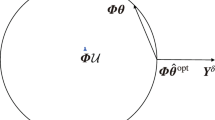Abstract
In Bayesian network parameter learning, it is difficult to obtain accurate parameters when the data are insufficient, and overfitting easily occurs. However, underfitting is prone to happen when the learning results are blindly close to the constraints generated by expert knowledge. A soft-hard constraint parameter learning method is proposed to balance the overfitting and underfitting problems in parameter learning. In this paper, the constraints applied to the parameters are called hard constraints, while those used to the prior are called soft constraints. A partial maximum entropy prior quantization method is proposed for the soft constraint to obtain proper parameters. The equivalent sample threshold is proposed to limit the hyperparameters based on the actual data size for the hard constraint. To combine soft and hard constraints effectively, the soft constraint maximization and hard constraint minimization model is proposed. Experimental results show that this method can significantly improve the accuracy of parameter learning and actually balance overfitting and underfitting.









Similar content being viewed by others
Explore related subjects
Discover the latest articles, news and stories from top researchers in related subjects.References
Pearl J (1988) probabilistic reasoning in intelligent systems: networks of plausible inference San Mateo. Comput Sci Artif Intell 58(2):721
Chen G, Ge Z (2020) Robust bayesian networks for low-quality data modeling and process monitoring applications. Control Eng Pract 97(104344):1–14
Zhang Y, Weng WG (2020) Bayesian network model for buried gas pipeline failure analysis caused by corrosion and external interference. Reliabil Eng Syst Safety 203:107089
Fg A, Nm B (2020) A new scoring system for the rapid entire body assessment (reba) based on Fuzzy sets and Bayesian networks. Int J Ind Ergon 80:103058
Zhang GH, Chen W, Jiao YY, Wang H, Wang CT (2020) A failure probability evaluation method for collapse of drill-and-blast tunnels based on multistate Fuzzy Bayesian network. Eng Geol 276(9):105752
Zhang T, Zhang T, Li C, Zhai X, Huo Q (2021) Complementary and alternative therapies for precancerous lesions of gastric cancer: a protocol for a Bayesian network meta analysis. Medicine 100(2):24249
Shree SRB, Sheshadri HS (2018) Diagnosis of Alzheimer’s disease using naive Bayesian classifier. Neural Comput Appl 29(3):123–132
Kaghazchi A, Shahdany SH, Roozbahani A (2021) Simulation and evaluation of agricultural water distribution and delivery systems with a hybrid bayesian network model. Agric Water Manage 245(c):106578
Alkheder S, Alkhamees W, Almutairi R, Alkhedher M (2021) Bayesian combined neural network for traffic volume short-term forecasting at adjacent intersections. Neural Comput Appl 33:1785–1836
Redner RA (1984) Mixture densities, maximum likelihood and the em algorithm. Siam Rev 26(2):195–239
Yang Y, Gao XG, Guo ZG (2015) Learning bn parameters with small data sets based by data reutilization. Acta Auto Sin 41(12):14
Xgg A, Zgg A, Hao RA, Yu YA, Dqc B, Cch A (2019) Learning bayesian network parameters via minimax algorithm. Int J Approx Reason 108:62–75
Xt A, Xg A, Zw A, Cha B (2021) Bidirectional heuristic search to find the optimal Bayesian network structure. Neurocomputing 41(426):35–46
Dai J, Ren J, Du W, Vladimir S, Ma J (2020) An improved evolutionary approach-based hybrid algorithm for Bayesian network structure learning in dynamic constrained search space. Neural Comput Appl 32:1413–1434
Zw A, Xg A, Xt A, Yu YB, Dc C (2021) Learning Bayesian networks based on order graph with ancestral constraints. Knowl Based Syst 211:106515
Dempster AP (1977) Maximum likelihood from incomplete data via the em algorithm. J R Stat Soc 39(1):1–38
Liao W, Qiang J (2009) Learning Bayesian network parameters under incomplete data with domain knowledge. Pattern Recogn 42(11):3046–3056
(2020) Learning parameters of bayesian networks from datasets with systematically missing data: a meta-analytic approach. Exp Syst Appl 141:112956
Guo ZG, Gao XG, Di RH (2014) Learning Bayesian network parameters under dual constraints from small data set. Acta Auto Sin 40(7):1509–1516
Yun Z, Norman F, Cheng Z (2016) An empirical study of bayesian network parameter learning with monotonic influence constraints. Decision Support Syst 87(C):69–79
Campos C, Yan T, Qiang J (2008) Constrained maximum likelihood learning of bayesian networks for facial action recognition. In: Computer Vision-ECCV 2008, pp 168–181
Feelders A, Gaag L (2006) Learning Bayesian network parameters under order constraints. Int J Approx Reason 42:37–53
Feelders A, Gaag L (2012) Learning bayesian network parameters with prior knowledge about context-specific qualitative influences. comput Sci, pp 193–200
Yang Y, Gao X, Guo Z, Chen D (2019) Learning Bayesian networks using the constrained maximum a posteriori probability method. Pattern Recogn 91:123–134
Chang R, Wang W (2010) Novel algorithm for bayesian network parameter learning with informative prior constraints. In: The 2010 international joint conference on neural networks (IJCNN), pp 1–8
Guo ZG, Gao XG, Ren H, Yang Y, Di RH, Chen DQ (2017) Learning Bayesian network parameters from small data sets: a further constrained qualitatively maximum a posteriori method. Int J Approx Reason 91(09):22–35
Kullback S, Leibler RA (1951) On information and sufficiency. Ann Math Stat 22(1):79–86
Dasgupta S (1997) The sample complexity of learning fixed-structure Bayesian networks. Mach Learn 29(2):165–180
Clarke BS, Barron AR (1994) Jeffreys’ prior is asymptotically least favorable under entropy risk. J Stat Plan Inference 41(1):37–60
Suzuki J (1996) Learning bayesian belief networks based on the minimum description length principle: basic properties. Ieice Trans Fund 82(10):2237–2245
Lja B, Lz A, Ly C, Dw C (2019) Class-specific attribute weighted naive bayes. Pattern Recogn 88:321–330
Jiang L, Zhang L, Li C, Wu J (2019) A correlation-based feature weighting filter for naive bayes. IEEE Trans Knowl Data Eng 21(2):201–213
Funding
This work was supported by the National Natural Science Foundation of China (61573285).
Author information
Authors and Affiliations
Corresponding author
Ethics declarations
Conflict of interest
The authors declare no conflict of interest.
Additional information
Publisher's Note
Springer Nature remains neutral with regard to jurisdictional claims in published maps and institutional affiliations.
Rights and permissions
About this article
Cite this article
Ru, X., Gao, X., Wang, Y. et al. Learning Bayesian network parameters with soft-hard constraints. Neural Comput & Applic 34, 18195–18209 (2022). https://doi.org/10.1007/s00521-022-07429-5
Received:
Accepted:
Published:
Issue Date:
DOI: https://doi.org/10.1007/s00521-022-07429-5




